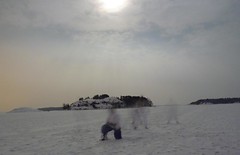After having skipped Frozy Camp last year, I gladly accepted this year's invitation to Pakkasleiri, a traditional winter seminar organized by Finnish Nanbudo Federation. The seminar was held on the last January weekend (29th – 31st Jan) in Vienola Youth Camping Resort, located on Rymättylä island, some 40 kilometres from Turku centre.
As we arrived on the site we found a spacious cottage offering more than enough place for 5 participants. One corner of the bunk beds was to some extend even separated from the rest of the bunk beds, so I immediately declared that corner to be my lady’s parlour as I was the only female participant.
We did not want to lose too much time; therefore we started searching for our warm clothing to put it on under the nanbudogi. The layers I had put on turned out very effective in protecting against the freezing cold outside. It must have been more than -15°C but the evening training in the moonlight on the frozen sea was great.
Usual technique for the first training is ukemi taiso and there was no exception this year either. Some fresh fluffy snow on ice was very welcome as it softened the ground for doing the ukemis. Or was it maybe also because I was dressed like a bear that falling on ice was not as painful as I remembered from the previous Frozy Camps. After having done enough mae kaiten ukemi, ushiro kaiten ukemi _and _yoko ukemi, we did also kaiten geri gedan in standing position (final position in kokutsu dachi) as well as the variation where one finishes on the knee.
Sunny Saturday morning gave me some false hope that it might be not that could outside. The fact was that despite the sun there were only few degrees more than last evening – meaning that the temperature was still much below -10°C.
The Saturday outdoor training was dedicated to Nanbu sandan kata and _bunkai randori _techniques where sensei showed us several possible ways how to apply kata techniques in a fight. A special challenge was to perform the kata the best one could as sensei announced that he would be filming us for a feedback after the training. It was not that easy with all those clothes on, heavy shoes and on the slippery surface underneath.
After restoring the energy with some food, it was time to read two chapters of the book Kodo, Ancient Ways by Kensho Furuya. It was the topic of the theoretical part of the seminar where we discussed what we had read. Also Nanbu sandan remained the topic of the training and sensei encouraged us to think of more sophisticated application of kata techniques in a fight. Kalle and I dealt with ichiban and niban part of randori while Andrej and Antti dealt with sanban and yonban. The objective was to create the defense techniques to the well-known randori attacks by using the elements of Nanbu sandan. Furthermore, we had to demonstrate what we had come up with and explain/show to the others from which part of the kata we deducted individual techniques.
The theory training was followed by another indoor training covering Nanbu sotai issues. Suddenly the cottage did not seem that spacious any more although we moved the benches and the tables aside. _KI _was flowing as we “danced” with the soft moves of receiving and returning the attacks.
In the evening we warmed up the sauna and enjoyed the privilege of the wholesome heat combined with the short escapes to the snowy land outside.
Once we were done in sauna, there was another training supposed to take place in the cottage. It seemed that the Slovenian participants had enough for that day but the Finns still did some secret techniques with wooden weapons – jo and bokken.
There was one more outdoor training left on Sunday. We walked on the frozen sea almost half way to the nearest island. It was Nanbu godan and bunkai randori time. First we did the first half of the kata, then sensei showed us the application for Nanbu godan bunkai randori ichiban and niban. Afterwards we did the second half of the kata and were instructed how to apply the techniques in sanban and yonban part of the randori.
The most exciting part of the training was the final thing we did: Nanbu godan bunkai randori yoningake – meaning that each time one of us was uke and the other four were toris. As everybody did their roles, we kneeled down in seiza position and let force (voima/moč), courage (rohkeus/pogum) and conviction (uskomus/prepričanje) echo over the snowy winterland. This year’s Frozy Camp was over. Packing up, cleaning the cottage – and it was time to say goodbye.
Winter in Finland is nice because it brings with it this unique opportunity of the extraordinary trainings on ice and snow. Thank you for the invitation!
Nika Simnovec, 1 dan (shitoryu)
